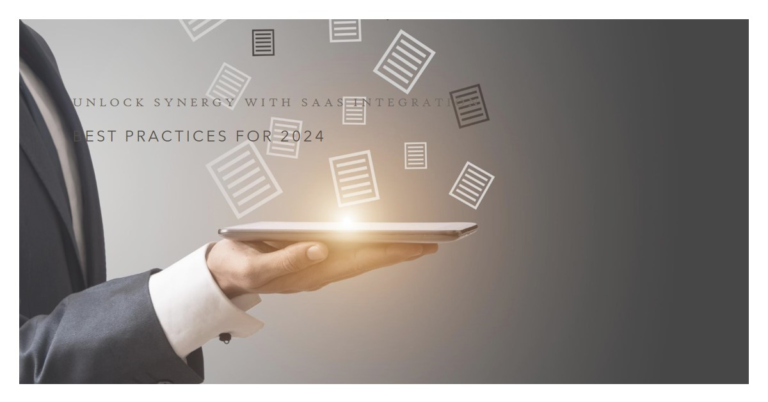The modern business landscape thrives on a diverse software ecosystem. With the ever-growing popularity of Software-as-a-Service (SaaS) solutions, enterprises are increasingly adopting a multi-cloud strategy, employing a range of specialized SaaS products to manage everything from customer relationships (CRM) to project management and marketing automation. While these individual tools offer immense functionality, the true magic lies in their ability to work together seamlessly. Here’s where effective SaaS integration becomes crucial.
The Challenge of Data Silos and Disconnected Workflows
A report by Salesforce reveals that 73% of salespeople waste an average of two hours per day on data entry across multiple systems. This highlights a critical issue: without proper integration, data remains siloed within each SaaS application, leading to duplicated efforts, inconsistencies, and a fragmented user experience. Disconnected workflows can further hamper productivity and hinder collaboration across departments.
The Power of a Unified Ecosystem
Integrating your SaaS products fosters a unified enterprise ecosystem, where data flows freely and applications work in harmony. This translates into a multitude of benefits:
- Enhanced Productivity: Streamlined workflows eliminate repetitive tasks and manual data entry. Information automatically populates between applications, saving valuable time and reducing human error.
- Improved Decision-Making: A holistic view of data empowers businesses to make data-driven decisions. Integrated analytics across tools provide deeper insights into customer behavior, campaign performance, and overall business health.
- Boosted Collaboration: Seamless information sharing fosters better teamwork across departments. Teams can access and collaborate on real-time data, leading to more efficient project execution.
- Increased Customer Satisfaction: When CRM, marketing automation, and support solutions integrate, businesses gain a 360-degree view of the customer. This fosters personalized interactions and ultimately enhances customer satisfaction (Source: Zendesk).
Best Practices for Seamless SaaS Integration
Building a well-integrated SaaS ecosystem requires careful planning and strategic execution. Here are key best practices to consider:
- Define Your Integration Goals: Identify the areas where integration will deliver the most significant value. Are you aiming to streamline lead generation, automate workflows, or improve customer service? Having clear goals helps determine the specific integrations needed and guides the overall strategy.
- Choose the Right Integration Approach: There are various methods to connect SaaS applications. APIs (Application Programming Interfaces) offer a standardized way for applications to communicate. Integration platforms as a service (iPaaS) provide pre-built connectors and a user-friendly interface to facilitate integration without extensive coding. Cloud-based data warehouses act as a central repository for data from different SaaS tools, enabling unified analytics.
- Prioritize Data Security and Governance: Data security is paramount. Evaluate the security protocols of each SaaS provider and ensure their compliance with relevant regulations. Establish clear data governance policies to ensure data accuracy, consistency, and access control across the integrated system.
- Standardize Data Format and Terminology: Inconsistencies in data formatting and terminology can lead to integration errors. Define clear data standards and ensure all SaaS applications adhere to them. This promotes seamless data flow and simplifies data analysis.
- Adopt a User-Centric Approach: Consider user experience during the integration process. Ensure the integrated system is intuitive and easy to navigate for all users across different departments.
- Invest in Change Management: A successful integration strategy goes beyond technology. Prepare your workforce for the changes ahead. Provide training and address any concerns to ensure user adoption and optimal utilization of the integrated ecosystem.
Adapting to Evolving Needs: Software SaaS and CRM in 2024
The landscape of SaaS solutions is constantly evolving. As highlighted in a recent industry report by Gartner, a key trend for 2024 is the growing demand for “composable applications.” These modular SaaS solutions allow businesses to pick and choose the functionalities they need and integrate them seamlessly with existing tools. This approach provides greater flexibility and agility as enterprises adapt to changing business needs.
In the realm of CRM specifically, the focus is shifting towards building deeper customer relationships. AI-powered features that personalize customer interactions and automate communication are gaining traction. Integrating CRM with marketing automation and customer service software further enhances the customer experience journey.
FAQs
- What are the costs associated with SaaS integration?
The cost of integration can vary depending on the complexity of the project, the number of applications involved, and the chosen integration method. Cloud-based solutions and iPaaS platforms often offer cost-effective options compared to custom development.
- Can I integrate legacy on-premise applications with SaaS tools?
Yes, it
is possible to integrate legacy on-premise applications with SaaS tools. There are various approaches, including using APIs, middleware solutions, or data migration services. The feasibility and cost will depend on the specific technologies involved.
- How do I ensure the ongoing success of my SaaS integrations?
Regular monitoring and maintenance are critical. Monitor the performance of your integrations and address any errors promptly. Stay updated on new features and functionalities offered by your SaaS providers, and adapt your integrations accordingly.
- What if I need help with planning and implementing my SaaS integrations?
Many IT service providers offer expertise in SaaS integration. These specialists can help you assess your needs, design an integration strategy, and implement the chosen solution. [Company Name] (replace with P99Soft) is an example of a company that can assist with software SaaS and CRM integration in 2024, focusing on best practices to create a cohesive enterprise ecosystem.
Conclusion
In today’s dynamic business environment, a well-integrated SaaS ecosystem is no longer a luxury, but a necessity. By following these best practices and adapting to evolving needs, enterprises can unlock the true potential of their SaaS investments, fostering collaboration, boosting productivity, and ultimately achieving a significant competitive edge. But the question remains: Are you ready to transform your business through the power of seamless SaaS integration?
Also know Key Considerations for IT Consultants in E-Governance



